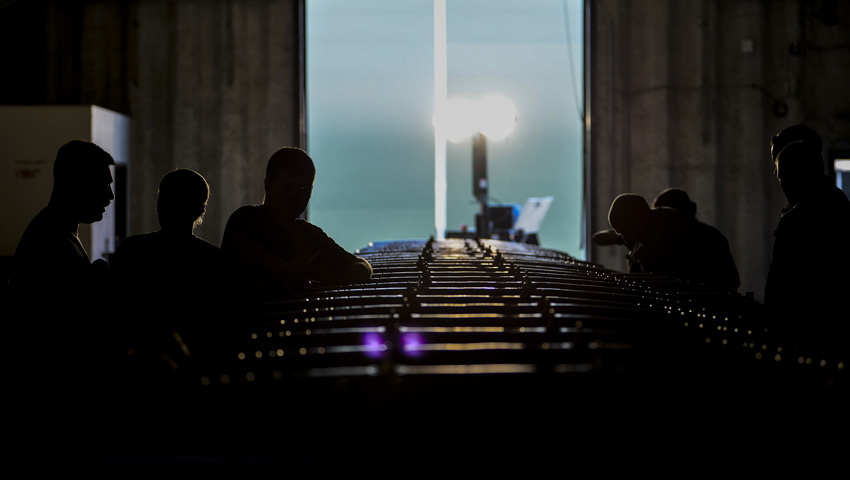US Air Force personnel from the 354th Maintenance Squadron munitions flight built the first bombs intended for the 354th Fighter Wing’s F-35A Lighting IIs as part of the growing Joint Strike Fighter contingent based in the Indo-Pacific.
To continue reading the rest of this article, please log in.
Create free account to get unlimited news articles and more!
The last time a 354th FW unit dropped combat-specific bombs was about 10 years ago when the A-10 Thunderbolt II and F-16 Fighting Falcons flew in the Alaskan skies.
A bomb build is the intricate process munitions personnel go through to ensure a bomb body is usable for the operators. Before a single bomb can be built, the munitions flight must co-ordinate and plan accordingly. The munitions are initially ‘barged’, which is a process of receiving, transporting, and storing the explosives. Eielson Air Force Base conducted its largest barge in years in April.
Captain Christina Merritt, a 354th MXS operations officer, said, "During this process, and depending on the bomb they are building, AMMO will add a guidance and control unit, tail kit and fuse to a basic bomb body. Each of these components work together to make up the type and purpose of the bomb."
Once the barge is complete, the munitions Airmen then move onto bomb assembly. The munitions flight typically builds bombs in mass fashion especially when they are dealing with the largest shipment Eielson has received in quite some time.
Master Sergeant Jason Brackins, the 354th MXS conventional maintenance non-commissioned officer in charge said, "We’re going to be building a total of 70 bombs over the course of the week. We’re the ones that bring the fight to the aircraft and give them that offensive posture."
Munitions are a key component to ensuring Eielson’s F-35s meet all goals for initial combat capabilities and RED FLAG-Alaska participants have ammunition to train. The Airmen who build them are the ones ensuring Eielson’s warfighters are prepared for the future fight.
The junior Airmen in the munitions flight know how impactful the first bomb build is for the F-35s here at the fighter wing and for Pacific Air Forces (PACAF).
Airman 1st Class Daelyn Mayer, a 354th MXS conventional maintenance inspector, added, "It is very rewarding to be a part of making history. I think it’s awesome to get to say we built the first bombs for the F-35s that are here at Eielson."
This comes following revelations that the US Senate Armed Services Committee has officially launched a Pacific Defense Initiative (PDI) to allocate funding and resourcing to better support tactical and strategic posture.
As part of the proposed PDI, the US Senate is asking for US$7 billion ($10.2 billion) to help support America's largest combatant command, INDOPACOM, counter the rise of China and Russia.
The Senate Armed Services Committee has requested US$1.4 billion ($2 billion) for next year, with an additional US$5.5 billion ($8 billion) for the fiscal year 2022 to augment missile defence in support of regional partners, and critically, forward deploy more troops in the Indo-Pacific.
This comes in addition to a US$20 billion ($33.35 billion) request made earlier in the year, which aims to expand the qualitative and quantitative edge enjoyed by the US and support the regional alliance frameworks, which head of INDOPACOM, Admiral Phil Davidson, describes as "Regain the Advantage".
A critical component of the approved NDAA includes plans for the US Air Force to establish a new F-35A Joint Strike Fighter operating facility in the Indo-Pacific "quickly to posture ready forces in our priority arena", the committee states.
This was expanded upon by committee chairman, senator Jim Inhofe, who articulated the growing need for more F-35s in the Indo-Pacific, stating, "It doesn't matter how many F-35s the military buys if very few are stationed in the region, their primary bases have little defence against Chinese missiles, they don't have secondary airfields to operate from, they can't access prepositioned stocks of fuel and munitions, or they can't be repaired in theatre and get back in the fight when it counts.
"The Pacific Deterrence Initiative will incentivise increased focus on posture and logistics, and help measure whether these requirements are being matched with resources."
The PDI follows on from the original 'European Deterrence Initiative', which was established in the aftermath of Russia's pseudo-invasion of the Crimea in 2014, something that has drawn the attention of Randall Schriver, the Pentagon's former top-Pacific policy official, seeing similarities between Crimea and the rising challenge of China in the Indo-Pacific.
This renewed posturing, tied to funding provides an opportunity for Australia to position the nation as a potential integrated hub for all US and allied F-35s operating in the Indo-Pacific with the added security and industry advantages associated with the Australia-US alliance.
Stephen Kuper
Steve has an extensive career across government, defence industry and advocacy, having previously worked for cabinet ministers at both Federal and State levels.

 Login
Login








